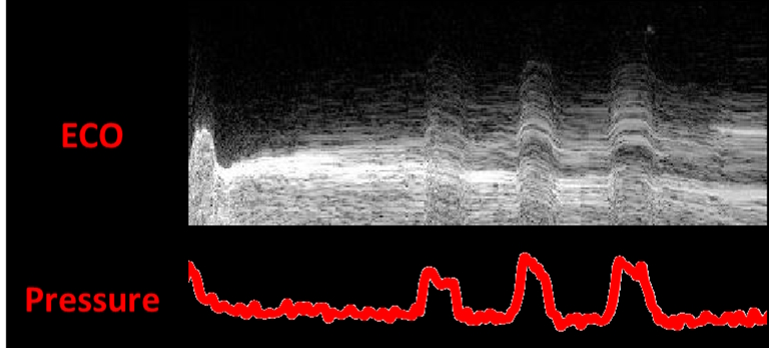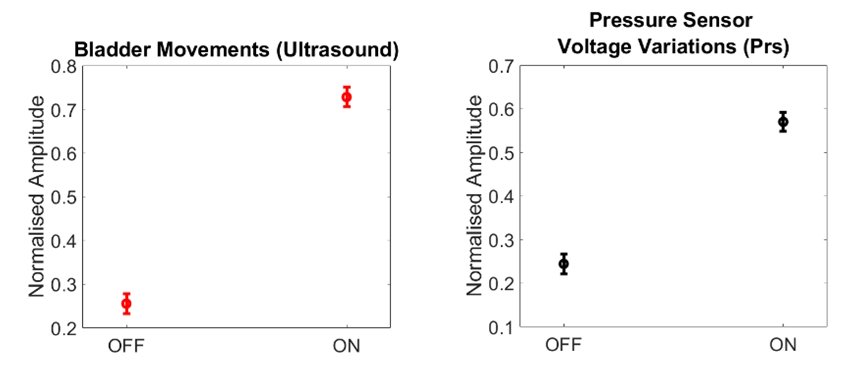Session Information
Date: Sunday, November 17, 2024
Title: Orthopedics, Low Back Pain, & Rehabilitation – ACR/ARP Poster
Session Type: Poster Session B
Session Time: 10:30AM-12:30PM
Background/Purpose: Men with rheumatic and musculoskeletal diseases (RMD) often experience sexual dysfunctions such as pelvic floor pain and erectile dysfunctions, which affect their sexual well-being. Pelvic floor muscle training (PFMT) can help to improve symptoms related to sexual dysfunctions. However, recruiting pelvic floor muscles in the early phases of PFMT can be challenging due to a lack in muscle awareness. Physiotherapists may adopt invasive anal biofeedback probes to ease muscle awareness, but these devices can cause discomfort. External non-invasive biofeedback systems, especially for men, are underexplored in the literature despite their potential for monitoring pelvic floor muscle variations during contraction. An external pressure sensor beneath the perineum could indirectly monitor pelvic floor recruitment in men. This study aimed to determine if an external pressure device can monitor pelvic floor muscle contraction in healthy men.
Methods: An experimental repeated measures study design was conducted by synchronising data collection from an external sensorised inflatable system and a wireless ultrasound probe (Figure 1). Healthy men were asked to sit on the sensorised inflatable system, and the ultrasound probed positioned transabdominally on the suprapubic zone to get an image of the bladder base. Participants performed three trials, each comprising a sequence of three consecutive 2-second pelvic contractions followed by 2 seconds of rest. Data analysis involved a multivariate mixed-effect model to investigate whether there was a simultaneous increase in the normalised amplitude (NA) (dependent variable) across the different signals (ultrasound and pressure) during ON and OFF contraction phases (fixed effects). The correlations between and within signals of the repeated measures of the same participant were accounted as random effects.
Results: Twenty healthy men assigned at birth were recruited (mean ± standard deviation [26 ± 2 years old; 344 ± 146.6 mL bladder volume]). The NA estimated means of the bladder base movements during the OFF and ON phases were 0.25 (CI [0.23-0.28]) and 0.73 (CI [0.70-0.75]), respectively. The NA means of the external pressure signals during the OFF and ON phases were 0.24 [0.22-0.26] and 0.57 [0.54-0.59]. Figure 2 represents the graphic distribution of these values.
Conclusion: The synchronised amplitude variations in pressure and ultrasound signals suggest the effectiveness of an external pressure device for monitoring pelvic floor muscle contractions in men. Placing an external biofeedback pressure device below the perineum, in the early stages of PFMT, can indirectly monitor the contractions of muscle in men and holds promise for improving the management of sexual dysfunctions in men with RMD. Our findings suggest that such a technology could lead to better therapeutic outcomes, enhancing the quality of life for men with RMD.
To cite this abstract in AMA style:
Giardulli B, Job M, Recenti F, Leuzzi G, Muda A, Buccarella O, Testa M. Assessing Male Pelvic Floor Contractions Using a Novel External Pressure Device and Ultrasound [abstract]. Arthritis Rheumatol. 2024; 76 (suppl 9). https://acrabstracts.org/abstract/assessing-male-pelvic-floor-contractions-using-a-novel-external-pressure-device-and-ultrasound/. Accessed .« Back to ACR Convergence 2024
ACR Meeting Abstracts - https://acrabstracts.org/abstract/assessing-male-pelvic-floor-contractions-using-a-novel-external-pressure-device-and-ultrasound/


